When I first started playing electric guitar, I couldn’t get my hands on enough stomp boxes! It was more of a distraction than a learning experience! In this article, I’ll reveal how many guitar pedals you really need for the type of music you like to play.
Keep reading to get you moving in the right direction!
You can use the table of contents below to take you to the area that interests you. Click on the little box to open it, and then click on the section of the article you want to read, or you can read from start to finish if you want the full guitar pedal experience!
The Short Answer
I recommend you start with two or three pedals and add more as the need arises. If you’re a beginning guitar player, it’s essential to get pedals that will work best with the songs you play, the tone you’re looking for, and the guitar and amplifier you have. The types of pedals you need depend on your musical genre.
Keep On Reading (Below) To Learn More
What Is A Guitar Pedal?
When I say “guitar pedal,” I’m talking about a device that changes the tone of your guitar signal by electronically processing it. Guitar pedals are also called effects pedals and stomp boxes.
For this discussion, I will refer to these devices as separate little boxes on the floor or pedalboard. Still, they can also be multi-effects units with several effects (like reverb, delay, modulation, and distortion) built into one box.
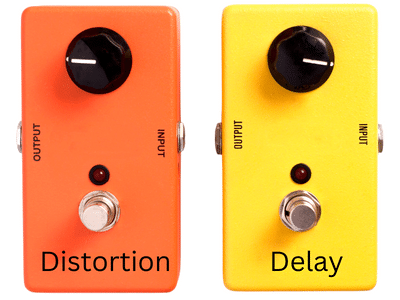
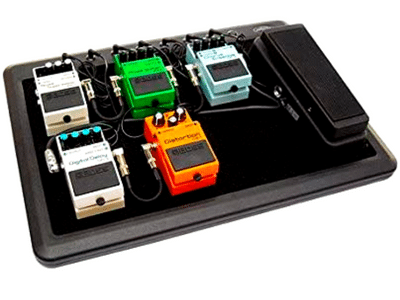
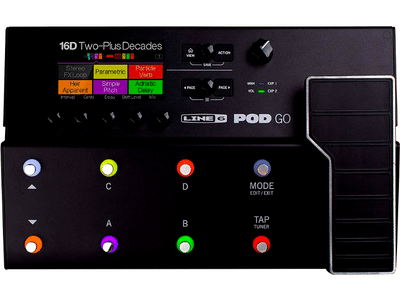
Beginner’s Guitar Pedal Buyer’s Guide

Here are some of the things you should consider as a beginning guitar player before buying pedals.
Can You Play Any Songs?
If you’re just beginning and you don’t know any songs, a guitar pedal is not going to do you any good! You would be better off spending that money to take guitar lessons or buy sheet music.
What Kind Of Music Do You Play?
Not all types of music require the use of pedals, even if you play an electric guitar. Ask yourself, is a guitar pedal going to improve the sound or just make it sound different?
Do You Already Have A Guitar And Amplifier?
If you don’t have an electric guitar or amplifier, effects pedals are useless! The money you save on not buying pedals can be put toward a better guitar or amplifier.
How To Power Guitar Pedals
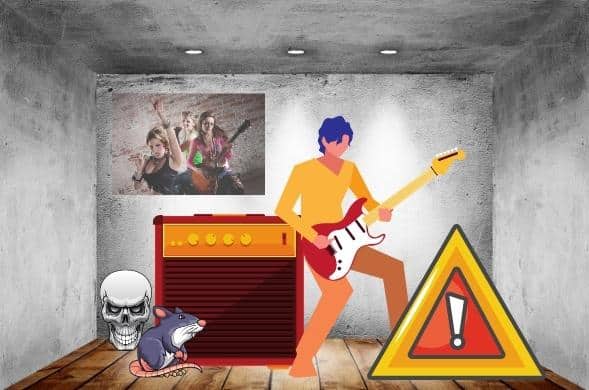
It’s essential to be aware of each pedal’s power requirements!
Guitar pedals can be run on a battery or a power supply. Most players eventually get a pedalboard and use a DC power adaptor to operate them.
If you use a power supply, it’s crucial to get the correct adaptor. Using the wrong power adaptor can permanently damage your pedal! You must match the power requirements (voltage and current) and use the right tip polarity.
Some adaptors require a center-negative tip polarity, while others need a center-positive polarity. If you need clarification on the pedal’s power and tip polarity requirements, contact the manufacturer to get the proper specifications!

Tip Polarity
When using a battery to power a guitar pedal, you must remember to unplug the guitar input cable to conserve energy when it is not in use, or you will kill the battery.
Why Do You Need Guitar Pedals?
So, what’s the big with guitar pedals? Pedals help you get the tone you need for the type of music you play. It’s that simple!
Pedals are mainly used for the electric guitar, but an acoustic player might use something like a reverb or delay pedal to make the sound bigger.
The first time I heard Keith Richards play the opening riff to “I Can’t Get No Satisfaction” in the 1960s, I knew I was never going to get that sound out of my guitar and amp. It turned out that he was using a Maestro Fuzz-Tone stomp box, which I promptly bought at my local music store, and I was in effects heaven!
If you play Rock, Metal, or Blues, chances are you’ll want a pedal, probably a few. However, some Country (e.g., Brad Paisley) and Jazz players (e.g., John Scofield) also use them.
How Many Pedals Do You Need?
If you’re reading this article and you’re a seasoned player, you probably have a collection of guitar pedals. I have a guitar pedal fetish, so they’re everywhere you look in my music room! But the real question is, how many do you actually need, especially if you’re a beginning player?
The bottom line is that the number and type of pedals you need will change as your musical repertoire, playing ability, and other equipment continue to evolve. If that sounds a little vague, read on, and I’ll make it clearer for you.
Here are some things to consider as you build your pedal collection.
The Type Of Music You Play
Different musical genres require various pedals. You wouldn’t use heavy distortion if you were playing a jazz standard like Satin Doll, but you might use little reverb or even a bit of delay.
Listen to recordings of the music you like and try to pinpoint the pedals used to make each sound. Read guitar magazines and go to online guitar pedal user groups. Many instructional videos can be helpful.
Perhaps all you need is the reverb built into your amp, and you can ditch the pedals altogether.
The Tone You Want
Different pedal makes and models will have different tones, even if they are the same type of effect. For example, you’ll never get the same sounds out of a Boss DS-1 that you’ll get from an Electro-Harmonix Big Muff, no matter how you adjust the knobs!
This is why a guitar player might have two or three different distortion pedals in the signal chain.
The Guitar You Use
The guitar you use can make a big difference in the way it activates your pedals. I remember the first time I plugged a Les Paul into my distortion booster that was adjusted for my Strat. The humbucking pickups in the Gibson guitar almost blew my head off!
Guitar neck and body tonewoods, as well as body thickness, affect its acoustic properties. Thicker bodies and denser woods have more natural sustain.
Pickups affect the signal output. Here are some generalizations of the characteristics of the three pickup designs.
Single-Coil pickups
Single-coil pickups have bright and focused sound but less sustain than humbuckers and active pickups. Their out is usually weak compared to other pickup types.
Humbucker Pickups
Humbuckers have a thicker, more midrange sound and more sustain than single coils. They have a significantly higher output than single-coil pickups.
Active Pickups
Active pickups have a darker sound with more emphasis on the lower frequencies, more sustain than a humbucker, and the highest out of the three.
The Amp You Have
The amp that you plug your pedals in can make all the difference.
Tube Amps
Tube amps have a very warm organic sound. They were the first amplifiers available, and you can hear their characteristic sound in older music. A good overdrive pedal can really make a tube amp sing!
Solid State Amps
Solid-state amps don’t use tubes. They use transistors in the pre-amp and power stages. These amps tend to sound harsher and more artificial than tube amps. They can be more reliable than using vacuum tubes
Non-Master Volume Amps
Non-master volume amps came before master volume amps. They have one volume control, so the pre-amp and amp sections can’t be adjusted separately. To get a naturally saturated or distorted sound, you have to crank the amplifier’s output volume almost all the way up and deal with the loudness.
Master Volume Amps
In an effort to make amplifiers more flexible and to give players a more saturated sound at lower output volumes, the pre-amps and amps sections were each given a volume control. These are great practice amps, especially for bedrooms!
High-Gain Amps
High-gain amps are designed to give the player the natural distortion and sustain that was previously only possible with a pedal. The amps may be less versatile than a master volume or multichannel amp. Using a dirt pedal with amp saturation can produce great Metal sounds!
Multi-Channel Amps
Multi-channel amps allow the player to have one channel set for clean sounds and a second channel that gives overdriven or distorted lead sounds. The player can switch channels in the middle of a song by simply hitting the amp’s footswitch.
Modeler Amps
Modeler amps use computer chips to model sought-after amps and even effects pedals. Some of these modeler amps can eliminate the need for pedals. Although the models don’t sound as organic and dynamic as the real thing, the newer high-def models are very convincing!
Your Primary Focus
It’s essential to define your musical focus. Beginning players may want to focus more on the discipline of learning to play music by setting up a routine practice schedule.
As a beginner, you should consider staying with the basic pedals, a guitar tuner, and maybe a distortion or delay pedal.
Sometimes guitar pedals and other toys like modeling amps and digital recording studios can make your music time less productive. You can spend more time turning knobs and chasing sound than learning to play your instrument!
More advanced and gigging players may want to add more guitar pedals to enhance their sound further.
Your Budget
Your budget will ultimately determine the type and number of guitar pedals you buy. There is an extensive price range for the same pedal type. Everything from used to new to hand-built boutique pedals are available for all your effects needs.
It’s a good idea to play through a pedal before you drop the cash to hear what it will sound like through a guitar and amp similar to the one you use. If you can’t find the pedal at your local music store, there might be a helpful YouTube review that will give you a pretty good idea of what you can expect.
The resale value of non-vintage guitar pedals is not usually great, so take your time to find what’s right for you and only get what you need.
Types Of Pedals

A seemingly endless supply of guitar pedals is available, and more come out every day. Each pedal can be grouped into one of several types based on its overall functionality.
Here are the most common pedal types with a brief description of what they do. A “looper” pedal could also be added to this list, which digitally records a sound segment and plays it back repeatedly.
| Pedal Type | Usage | Function |
|---|---|---|
| Reverb | ✅✅✅ | Adds reverberation to audio signal |
| Delay | ✅✅✅✅ | Adds delay and echo to audio signal |
| Tremolo | ✅ | Makes audio signal louder and softer |
| Chorus | ✅✅✅ | Multiplies and modulates audio signal (for “thicker” sound) |
| Phase Shifter | ✅✅✅ | Frequency-based modulation (makes “whooshing” sound) |
| Flanger | ✅✅✅ | Time-based modulation (makes “flanging” sound) |
| Overdrive | ✅✅✅✅ | Boosts signal and adds sustain |
| Distortion | ✅✅✅✅ | Clips signal with mild to moderate distortion |
| Metal | ✅✅✅✅ | Aggressive distortion with high and low-frequency cuts |
| Fuzz | ✅✅ | Clips signal with severe distortion |
| Wah-wah | ✅✅✅ | Varies guitar signal tone |
| Compressor | ✅✅ | Keeps sound level constant and adds sustain |
| Graphic EQ | ✅✅ | Adjusts the lows, mids, and highs |
| Noise Gate | ✅✅✅ | Removes noise from guitar signal |
| Digital Tuner | ✅✅✅✅ | Tunes guitar |
Guitar Pedal Setups
The way you set up your guitar pedals can be just as important as the type of pedals you have. Certain pedals work best when put in the correct order and hooked up properly to your guitar and amplifier.
What Is An Effects Loop?
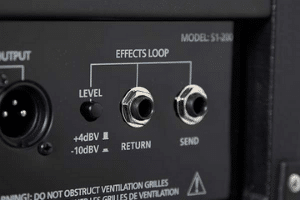
An effects loop is the part of a guitar amplifier’s electronic circuit that allows you to place guitar pedals between the amp’s preamp and amplifier sections. It “sends” the preamp signal to the pedal(s), which then “returns” to the amp section of the effects loop.
Not all guitar amplifiers have an effects loop, especially the older models. When an effects loop is available, it can be found on the back panel.
If you are in the market for a guitar amp, the need for an effects loop can be a critical consideration since it can’t be added after the fact. It’s either built into the amp, or it isn’t!
The other thing is that not every guitar player uses their amp’s effects loop. Some guitarists prefer to run all their effect pedals through the amp’s front end, between the guitar and the input jack. If your amp has an effects loop, it really comes down to a personal choice.
What Pedals Go In An Effects Loop
The effects loop is an ideal place to put modulation pedals. By modulation pedals, I mean Chorus, Phaser, Flanger, and Delay pedals. Technically speaking, Reverb and Tremolo pedals also fall under the modulation category.
Many guitar amps have a built-in reverb effect, and some vintage 50s and 60s amps come with built-in tremolo. If your amp has a built-in reverb, you can still put a digital reverb pedal in the effects loop to give you a better tone and more adjustment options like room, hall, spring, and plate simulations.
“Dirt” pedals, like Overdrive, Distortion, Fuzz, and Metal, should not be put in an amplifier’s effects loop. They should be placed between the guitar and the amp’s input jack to drive the amp’s preamp section.
What About Musical Genre?
The other thing to understand is that the genre of music you play will largely determine the types of pedals you need.
The next section will show representative setups for Rock and Metal, Blues, Country, and Jazz. These are the common pedals you will see guitarists of each genre use. However, many variations are possible.
How To Arrange Guitar Pedals
In the following section, I’ll also be sure to give you hints on the best order to hook up some types of pedals to each other, where applicable. Some of it is based on what sounds best, and other recommendations are based on my personal preference.
If your guitar amplifier does not have an effects loop, you can skip here to see the pedal order I recommend when connecting all your pedals to the front end.
Rock And Metal Pedal Setup
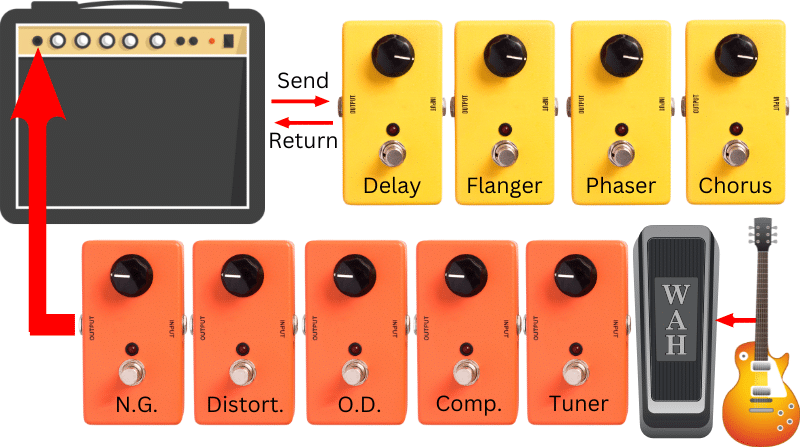
Rock and Metal players use a fairly similar pedal setup. Metal players tend to use more dirt than Rock players by combining (gain stacking) overdrive with distortion, fuzz, or metal pedals.
When two dirt (overdrive, distortion, fuzz, and metal) pedals are used simultaneously, the first pedal determines how aggressive the sound will be, and the second pedal sets the overall tone.
In this diagram, a fuzz or metal pedal can be added to the effects chain anywhere between the compressor and the noise gate.
I recommend you put the compressor before the dirt pedals to get the most dynamic sound and harmonics.
Put the noise gate last for the best sound and quietest signal.
All the modulation effects should go in the amp’s effects loop. I recommend you put the Delay pedal last in the effects loop.
Blues Pedal Setup
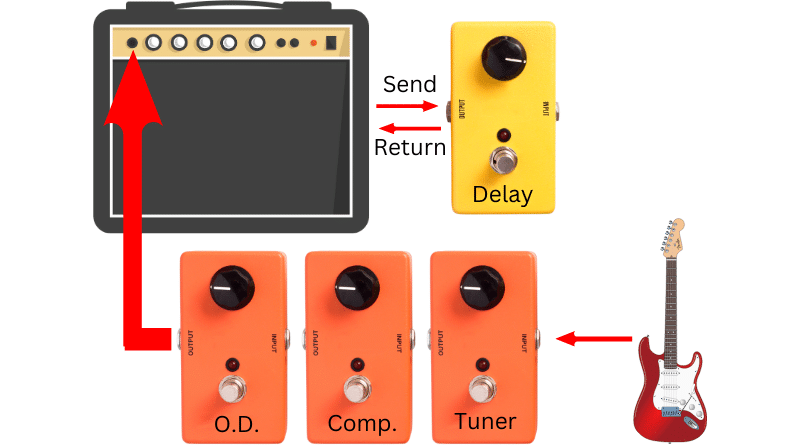
When I say “blues” player, I’m not referring to someone that plays Rock with some Blues tunes. I’m talking about someone like the great Buddy Guy, a “blues man!”
Blues players tend to use fewer guitar pedals than Rock and Metal Players. They might use a compressor to level out their sound and add sustain. They commonly use an overdrive pedal to add a little extra dirt to chords and make the guitar “sing” during solos.
They might not need the overdrive pedal if they have a guitar with high-output pickups, like humbuckers, or a high-gain amp.
Players like B.B. King, Albert King, Freddie King (none of which were related to each other), and Albert Collins just cranked up their amp and let it do all the work, giving them a very organic and subtle overdrive without pedals!
A delay pedal can be put in the effects loop to make the sound “bigger.” If the amp doesn’t have a built-in reverb circuit, a Reverb pedal can also be added to the effects loop, usually before the Delay pedal.
Country Pedal Setup
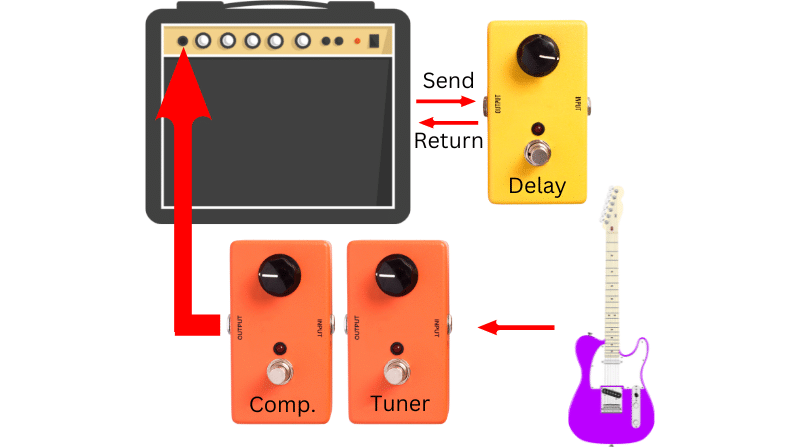
Traditionally, country players don’t tend to use much in the way of guitar pedals. They like to use a compressor to fire up their double-stop bends and chicken pickin’ licks. Some of the newer pickers, like Brad Paisley, can use pretty hefty pedalboards resembling a rock setup.
A Delay pedal may be thrown in the effects loop to give their awesome solos a little extra sparkle.
Since most country players favor the twang of a single-coil Tele, they tend to rely on an amp with a lot of natural gain and headroom. Brad seems to be favoring Dr. Z amps these days, but many pickers prefer the Fender sound.
Jazz Pedal Setup
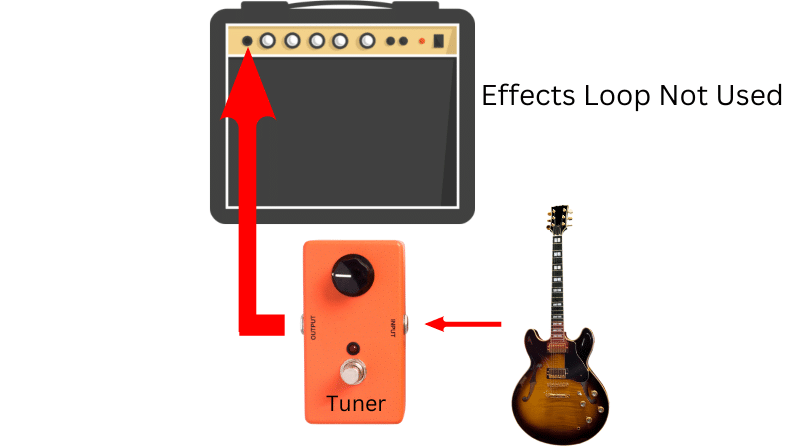
Players that are “Jazz purists” can be notorious for skipping the pedals altogether, even eliminating the tuner pedal by using a clip-on version.
However, many Jazz-Rock and Fusion players use a variety of modulation pedals and a little bit of dirt in the form of overdrive and mild distortion. People like Lee Ritenour and Pat Metheny will throw some modulation pedals in the effects loop.
Pedal Setups For Amps Without An Effects Loop
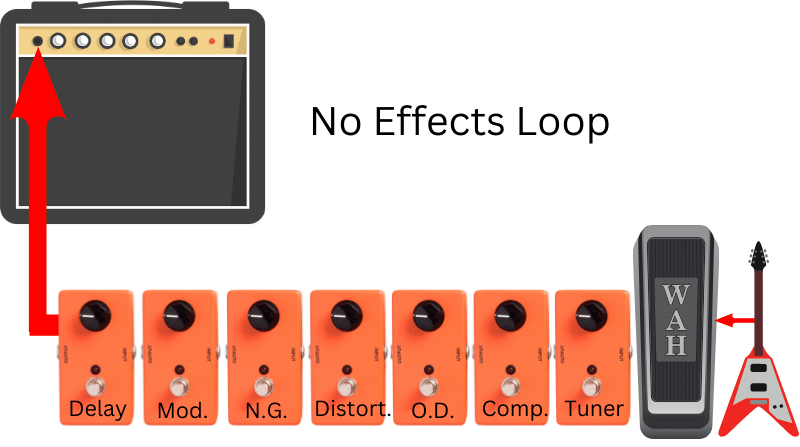
Comp. = Compressor, Mod = Modulation
If your amp doesn’t have an effects loop or if you want to put all your guitar pedals on the front end, here’s the order I recommend.
Put your compressor before the dirt and modulation pedals.
The noise gate pedal should be after the compressor and dirt pedals but before the modulation pedals. Putting the noise gate after the modulation pedals will be less noisy, but it can also prematurely cut off some of the “sweep” effects of the mod pedals.
Modulation pedals can be Chorus, Phaser, Flanger, Delay, Reverb, and Tremolo.
Frequently Asked Questions

Here are some of the questions I get asked about guitar pedals.
If your question does not appear here, please put it in the comments, and I will get right back to you with an answer.
What Pedals Should You Get First (“Must Have” Guitar Pedals)?
It’s usually best to begin with a tuner, distortion, and delay pedal. You can always add a modulation (chorus, phaser, and flanger) pedal if the need arises. Some players use a clip-on guitar tuner, which can be a cheaper alternative to a tuner pedal.
What Is The Most Popular Effect Pedal?
The most popular guitar effect is the Distortion pedal. Distortion is one type of “dirt” pedal. Overdrive, Fuzz, and Metal stomp boxes are other dirt pedals.
Does It Matter What Order You Put Your Pedals In?
As discussed above, there are preferred ways to hook up guitar pedals, but ultimately, you should connect them in the order that sounds best to you.
How Do You Take Care Of Guitar Pedals?
Guitar pedals need to be kept clean and unplugged if they are running on battery power. Test the battery before each gig.
f you use a collection of pedals, you can connect them on a pedalboard to a single power supply. Keep the pedals off the floor when they are not being used to avoid damaging them/
Do Pedals Need AC Or DC?
Most pedals require a DC (direct current) power source, which is supplied by a power adaptor. Using the correct adaptor with the proper voltage, wattage, and tip polarity is essential, or you could permanently damage the guitar pedal.
Some multi-effects units use an AC (alternating current) power supply.
Can I Use A Pedal Without An Amp?
No, most guitar pedals are not meant to be used without an amplifier. Some multi-effects pedals have a headphone jack, which allows you to listen without an amp.
Should I Unplug Pedals When Not Playing?
Yes, if your pedals are running on batteries, the “guitar-in” cable needs to be unplugged after playing to prevent the battery from being drained by the pedal. The “in” jack of the pedal has a circuit that disconnects the battery when the cable plug is removed. If your pedal is being run on a power adaptor, it’s ok to keep it plugged in.
Final Thoughts

So, how many guitar pedals you need depends on your playing skill, the type of music you play, and the guitar and amplifier you use. If you are just learning to play, it’s better to concentrate on developing your skills and learning songs before you invest in guitar effects.
Ideally, a beginner should start with one to three pedals. I suggest a tuner, overdrive or distortion, and a delay pedal.
Never use guitar pedals to try to make yourself sound better than you are or to cover up mistakes in your playing. It’s essential to work on problem areas in your playing and then use pedals to add the tonal characteristics that take it to the next level.
It’s crucial to be aware of your pedal’s external power requirements to avoid damaging the unit with the wrong type of adaptor!
There are at least fifteen different pedal types (see the table above), with many makes and models to choose from in each type. Rock and Metal platers typically use the most guitar pedals. Guitar pedals are available to improve your tone, no matter what kind of music you play.
If you have a guitar amplifier with an effects loop, put your modulation pedals (e.g., Chorus, Flanger, Phaser, and Delay) in the effects loop and your dirt pedals (e.g., Overdrive, Distortion, Fuzz, and, Metal) between your guitar and amp input jack.
Related Article ➡ Why Do Guitarists Use So Many Pedals – Little-Known Secrets!
Related Article ➡ Can You Use Single Coil Pickups For Rock? – Ultimate Guide!

Here is a video from GuitarZero2Hero that demonstrates the basic sound of each pedal type. Check it out!
Tell Me What You Think

Please leave a comment below if you enjoyed this article, have any questions about guitar pedals, or want to give your point of view. I will be happy to help you.
- Which guitar pedals do you own?
- What’s your favorite pedal? Why?
- Do you put pedals in an effects loop? Which ones?
- Which pedal(s) do you want to buy?
- Do you get dirty sounds from a pedal, your amp, or both?
- What else is on your mind?

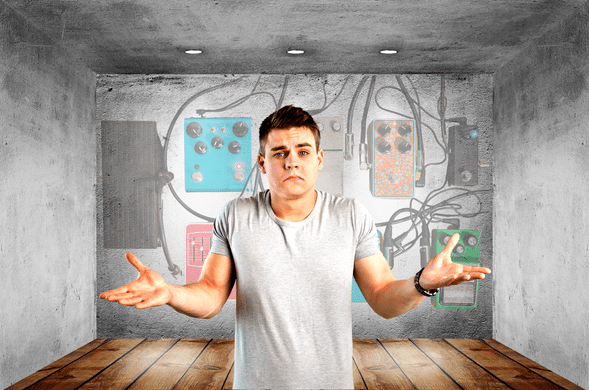

Hey there! I just read this awesome blog post about guitar pedals and it was super helpful for me as a beginner electric guitar player. I had no idea where to start with pedals, but this post broke everything down in a way that was easy to understand. It was cool to learn about the different types of pedals and how they can be used to create different sounds and effects. I’m super excited to start experimenting with pedals and I’m grateful for this post for giving me a good foundation to start from. Thanks for the awesome info!
Hi, Leo
Thank You for your comments!
I’m thrilled that this article helped you get started with guitar pedals. There’s really no end to the fun you can have with adding effects to your guitar’s tone!
Let me know if there’s any way I can assist you.
Happy Holidays!
Frank 🎸
Hi, thanks for this informative article. my sister played classical guitar for a while and we both love electric guitar. I think she should start working with pedals it’s so interesting. I agree with you that developing skills is more important and I think if a beginner starts with 3 or more pedals he or she could be disappointed I saw some people who gave up playing guitar because they expect too much of themselves. anyway, I’m going to get pedals for my sister.
Hi, Liam
Thank You for your comments!
Pedals are not the greatest for classical guitar tunes, but it’s true that some classical players use a small amount of reverb to make their sound bigger and give it more “depth.”
I recommend that you give the electric guitar a try and then add a few pedals after you’ve learned the basics and have a repertoire of songs.
Happy Holidays!
Frank
I’m switch from playing a 4 piece band to busking. My Boss Street Cube ll has reverb and chorus which I use. I play Stratocaster through a Klon clone, Joyo AceTone and MXR delay. I also have a Fulltone 2b, which I’m trying before the Klon or between the Klone and AceTone.
Hi, Jenny
That setup sounds fantastic! I have used the MXR delay in my pedalboards from as far back as I can remember. It’s an excellent pedal!
Rock On! ?
Frank ?
So much great information in this article! I’m gonna use this info to help me restructure my own pedalboard and understand my amp better. There were a lot of takeaways in this. Thank you.
Hi, Paul
My pleasure and I’m thrilled that you found the article helpful!
Have a Great New Year! ?
Frank ?